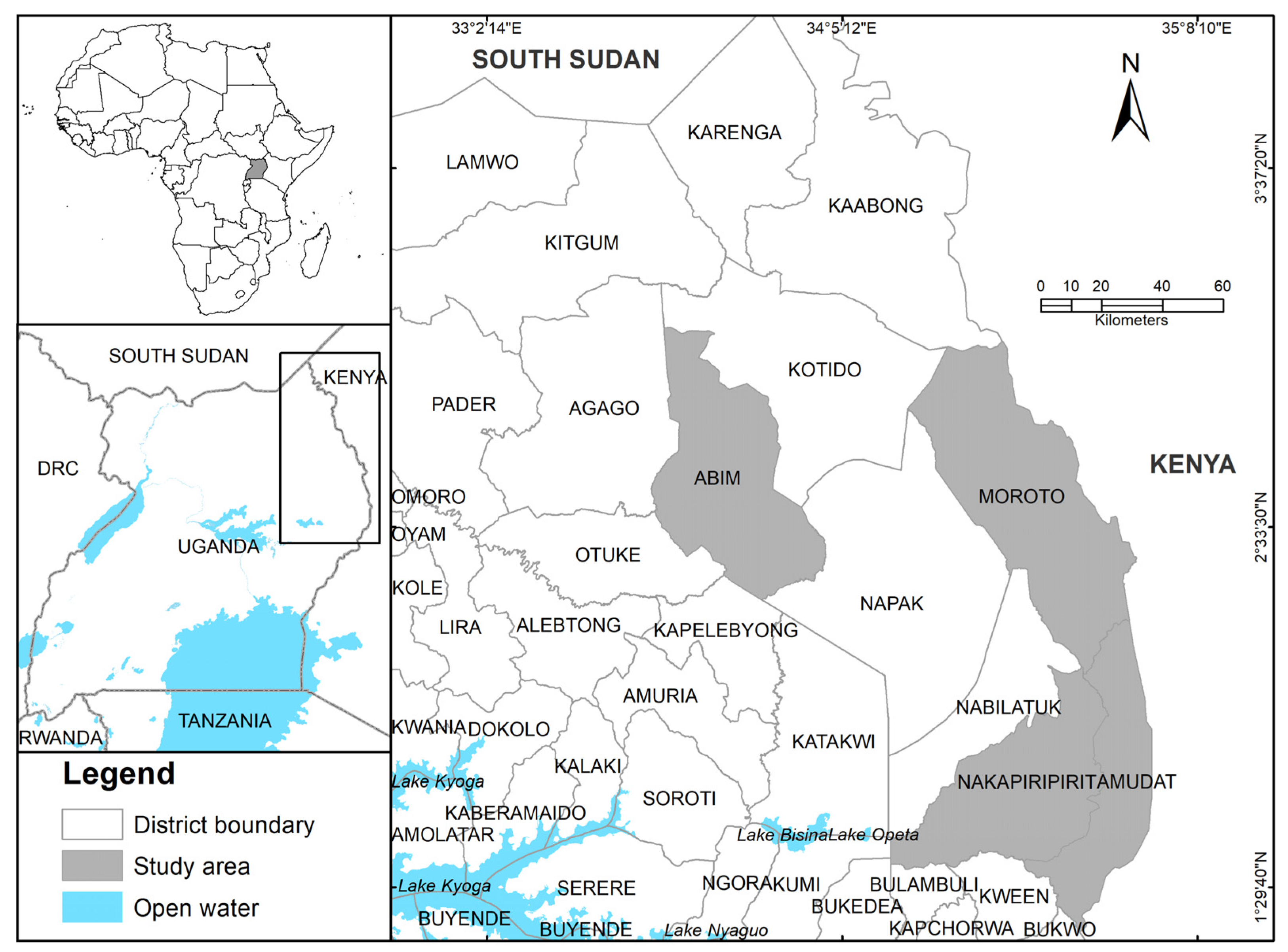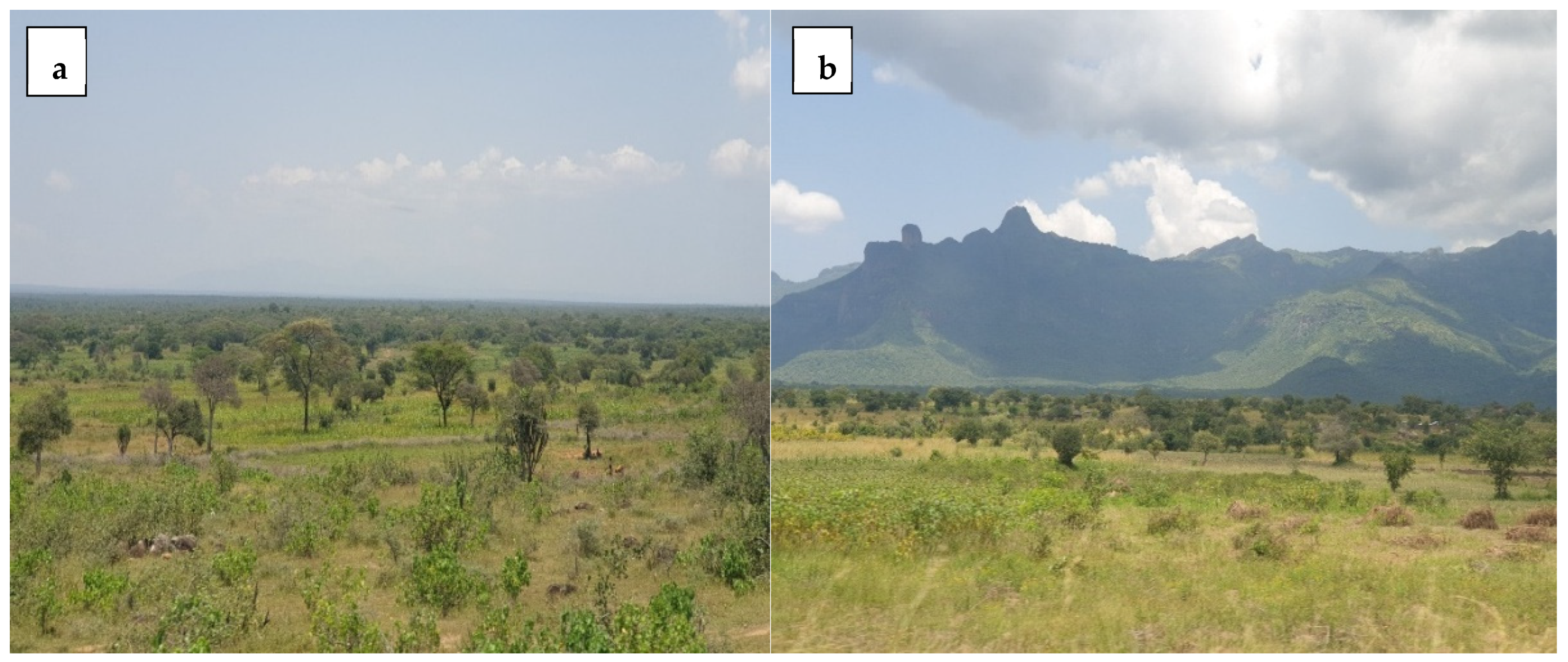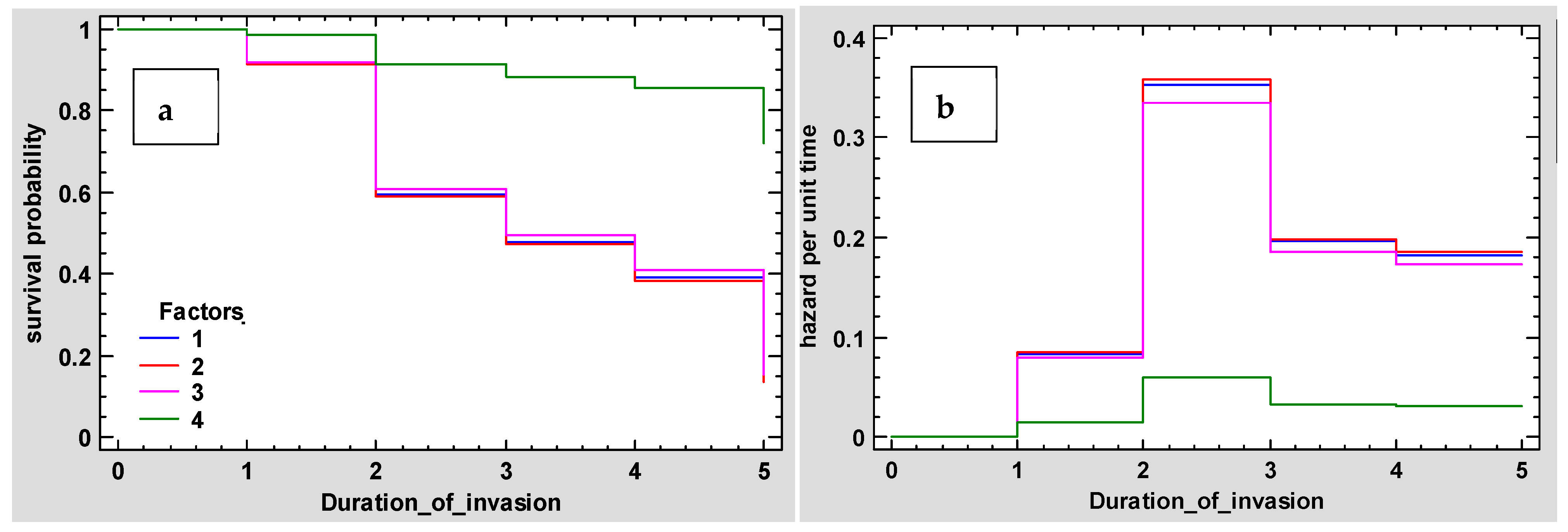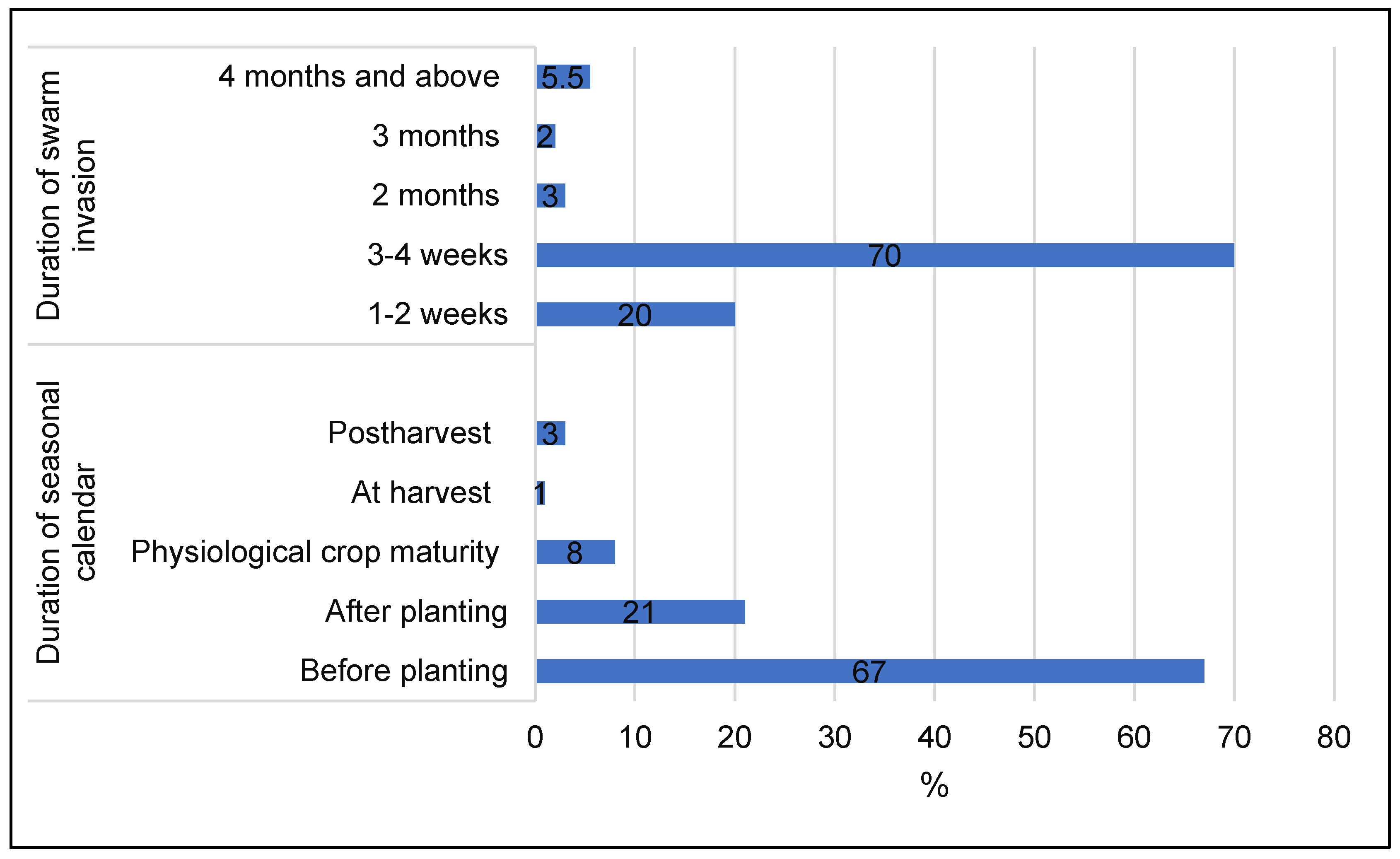Desert Locust Invasion in Uganda: Effects on Household Food Consumption and Effective Control Interventions
Abstract
:1. Introduction
2. Materials and Methods
2.1. Study Location
2.2. Data and Sources
2.3. Data Collection Methods
2.4. Data Analysis
3. Results
3.1. Drivers, Survival Rates, and Duration of Desert Locust Invasions
3.1.1. Environmental Drivers of Locust Invasions
3.1.2. Survival Probability of Desert Locusts
3.1.3. Duration of Desert Locust Invasions
3.2. The Impacts of Desert Locust Invasions on Household Consumption of Food Items
3.3. Effectiveness of Pest Control Measures and Sources of Information
3.3.1. Perceived Effectiveness of Implemented Locust Control Measures
3.3.2. Sources of Desert Locust Control Information
4. Discussion
5. Conclusions
Author Contributions
Funding
Informed Consent Statement
Data Availability Statement
Acknowledgments
Conflicts of Interest
References
- Yang, N.; Cui, X. Study on locust disaster monitoring based on SMOS L2 soil moisture data. In Proceedings of the IGARSS 2019—2019 IEEE International Geoscience and Remote Sensing Symposium, Yokohama, Japan, 28 July–2 August 2019; IEEE: Piscataway, NJ, USA, 2019; pp. 9413–9415. [Google Scholar]
- Roychoudhury, A. Desert locust: A menace to Indian agriculture and economy. Young Sci. Tomorrow’s Sci. Begins Today 2020, 4, 14–20. [Google Scholar]
- Landmann, T.; Agboka, K.M.; Klein, I.; Abdel-Rahman, E.M.; Kimathi, E.; Mudereri, B.T.; Malenge, B.; Mohamed, M.M.; Tonnang, H.E.Z. Towards early response to desert locust swarming in eastern Africa by estimating timing of hatching. Ecol. Model. 2023, 484, 110476. [Google Scholar] [CrossRef]
- Maeno, K.O.; Ould Ely, S.; Ould Mohamed, S.A.; Jaavar, M.E.H.; Ould Babah Ebbe, M.A. Adult desert locust swarms, Schistocerca gregaria, preferentially roost in the tallest plants at any given site in the Sahara Desert. Agronomy 2020, 10, 1923. [Google Scholar] [CrossRef]
- Meynard, C.N.; Lecoq, M.; Chapuis, M.P.; Piou, C. On the relative role of climate change and management in the current desert locust outbreak in East Africa. Glob. Chang. Biol. 2020, 26, 3753–3755. [Google Scholar] [CrossRef]
- Chen, C.; Qian, J.; Chen, X.; Hu, Z.; Sun, J.; Wei, S.; Xu, K. Geographic distribution of desert locusts in Africa, Asia and Europe using multiple sources of remote-sensing data. Remote Sens. 2020, 12, 3593. [Google Scholar] [CrossRef]
- Piou, C.; Gay, P.E.; Benahi, A.S.; Babah Ebbe, M.A.O.; Chihrane, J.; Ghaout, S.; Cisse, S.; Diakite, F.; Lazar, M.; Cressman, K.; et al. Soil moisture from remote sensing to forecast desert locust presence. J. Appl. Ecol. 2019, 56, 966–975. [Google Scholar] [CrossRef]
- Kimathi, E.; Tonnang, H.E.; Subramanian, S.; Cressman, K.; Abdel-Rahman, E.M.; Tesfayohannes, M.; Niassy, S.; Torto, B.; Dubois, T.; Tanga, C.M.; et al. Prediction of breeding regions for the desert locust Schistocerca gregaria in East Africa. Sci. Rep. 2020, 10, 11937. [Google Scholar] [CrossRef]
- Update on FAO’s response to the Desert Locust upsurge. In Proceedings of the Hundred and Twenty-Eighth Session, Rome, Italy, 18–22 May 2020. PC 128/INF/2.
- Salih, A.A.; Baraibar, M.; Mwangi, K.K.; Artan, G. Climate change and locust outbreak in East Africa. Nat. Clim. Chang. 2020, 10, 584–585. [Google Scholar] [CrossRef]
- Kassegn, A.; Endris, E. Review on socio-economic impacts of ‘Triple Threats’ of COVID-19, desert locusts, and floods in East Africa: Evidence from Ethiopia. Cogent Soc. Sci. 2021, 7, 1885122. [Google Scholar] [CrossRef]
- Chatterjee, S. How Hard Did That Sting? Estimating the Economic Costs of Locust Attacks on Agricultural Production. Appl. Econ. Perspect. Policy 2022, 44, 434–459. [Google Scholar] [CrossRef]
- Sultana, R.; Kumar, S.; Samejo, A.A.; Soomro, S.; Lecoq, M. The 2019–2020 upsurge of the desert locust and its impact in Pakistan. J. Orthoptera Res. 2021, 30, 145–154. [Google Scholar] [CrossRef]
- Xu, Z.; Elomri, A.; El Omri, A.; Kerbache, L.; Liu, H. The compounded effects of COVID-19 pandemic and desert locust outbreak on food security and food supply chain. Sustainability 2021, 13, 1063. [Google Scholar] [CrossRef]
- Samejo, A.A.; Sultana, R.; Kumar, S.; Soomro, S. Could Entomophagy Be an Effective Mitigation Measure in Desert Locust Management? Agronomy 2021, 11, 455. [Google Scholar] [CrossRef]
- Bag, H.; Bhoi, L. Desert locust and climate change: A risk for agriculture. Biot. Res. Today 2020, 2, 802–804. [Google Scholar]
- Wang, L.; Zhuo, W.; Pei, Z.; Tong, X.; Han, W.; Fang, S. Using long-term earth observation data to reveal the factors contributing to the early 2020 desert locust upsurge and the resulting vegetation loss. Remote Sens. 2021, 13, 680. [Google Scholar] [CrossRef]
- Peng, W.; Ma, N.L.; Zhang, D.; Zhou, Q.; Yue, X.; Khoo, S.C.; Yang, H.; Guan, R.; Chen, H.; Zhang, X.; et al. A review of historical and recent locust outbreaks: Links to global warming, food security and mitigation strategies. Environ. Res. 2020, 191, 110046. [Google Scholar] [CrossRef]
- Despland, E.; Collett, M.; Simpson, S.J. Small-scale processes in desert locust swarm formation: How vegetation patterns influence gregarization. Oikos 2000, 88, 652–662. [Google Scholar] [CrossRef]
- Therville, C.; Anderies, J.M.; Lecoq, M.; Cease, A. Locusts and people: Integrating the social sciences in sustainable locust management. Agronomy 2021, 11, 951. [Google Scholar] [CrossRef]
- Gartrell, B. Prelude to disaster: The case of Karamoja. In The Ecology of Survival; Routledge: Abingdon-on-Thames, UK, 2019; pp. 193–217. [Google Scholar]
- Egeru, A.; Barasa, B.; Nampijja, J.; Siya, A.; Makooma, M.T.; Majaliwa, M.G.J. Past, present and future climate trends under varied representative concentration pathways for a sub-humid region in Uganda. Climate 2019, 7, 35. [Google Scholar] [CrossRef]
- Challenge, S.; Egeru, A.; Nyombi, K. Soil carbon and nitrogen stocks in traditionally managed rangeland biomes in Karamoja sub-region, Uganda. Afr. Crop Sci. J. 2022, 30, 127–140. [Google Scholar] [CrossRef]
- Pandis, N. Cross-sectional studies. Am. J. Orthod. Dentofac. Orthop. 2014, 146, 127–129. [Google Scholar] [CrossRef] [PubMed]
- Khanakwa, P. Cattle Rustling and Competing Land Claims: Understanding Struggles Over Land in Bunambutye, Eastern Uganda. Afr. Stud. Rev. 2022, 65, 455–478. [Google Scholar] [CrossRef]
- Omona, D.A. The mainline churches and climate change in Uganda. In African Perspectives on Religion and Climate Change; Routledge: Abingdon-on-Thames, UK, 2022; pp. 104–119. [Google Scholar]
- Kroloff, E.K.; Heinen, J.T.; Braddock, K.N.; Rehage, J.S.; Santos, R.O. Understanding the decline of catch-and-release fishery with angler knowledge: A key informant approach applied to South Florida bonefish. Environ. Biol. Fishes 2019, 102, 319–328. [Google Scholar] [CrossRef]
- Sim, J.; Waterfield, J. Focus group methodology: Some ethical challenges. Qual. Quant. 2019, 53, 3003–3022. [Google Scholar]
- Elghannam, A.; Mesias, F.J.; Escribano, M.; Fouad, L.; Horrillo, A.; Escribano, A.J. Consumers’ perspectives on alternative short food supply chains based on social media: A focus group study in Spain. Foods 2019, 9, 22. [Google Scholar] [CrossRef]
- Bender, R.; Augustin, T.; Blettner, M. Generating survival times to simulate Cox proportional hazards models. Stat. Med. 2005, 24, 1713–1723. [Google Scholar] [CrossRef]
- Daoud, J.I. Multicollinearity and regression analysis. J. Phys. Conf. Ser. 2017, 949, 012009. [Google Scholar] [CrossRef]
- Sharma, A. Locust Control Management: Moving from Traditional to New Technologie—An Empirical Analysis. Entomol. Ornithol. Herpetol. 2015, 4, 1. [Google Scholar] [CrossRef]
- Klein, I.; Oppelt, N.; Kuenzer, C. Application of remote sensing data for locust research and management—A review. Insects 2021, 12, 233. [Google Scholar] [CrossRef]
- Van Huis, A.; Cressman, K.; Magor, J.I. Preventing desert locust plagues: Optimizing management interventions: Mini review. Entomol. Exp. Et Appl. 2007, 122, 191–214. [Google Scholar] [CrossRef]
- Zhang, L.; Lecoq, M.; Latchininsky, A.; Hunter, D. Locust and grasshopper management. Annu. Rev. Entomol. 2019, 64, 15–34. [Google Scholar] [CrossRef] [PubMed]
- Nakalembe, C.; Dempewolf, J.; Justice, C. Agricultural land use change in Karamoja Region, Uganda. Land Use Policy 2017, 62, 2–12. [Google Scholar] [CrossRef]
- Pius, L. Mobile Pastoralists: The Challenge of Livestock Markets in Karamoja Uganda; The Global Forum on Agricultural Research and Innovation GFAR: Rome, Italy, 2019; pp. 1–10. [Google Scholar]
- Prior, C.; Streett, D.A. Strategies for the use of entomopathogens in the control of the desert locust and other acridoid pests. Mem. Entomol. Soc. Can. 1997, 171, 5–25. [Google Scholar] [CrossRef]
- Showler, A.T.; Ould Babah Ebbe, M.A.; Lecoq, M.; Maeno, K.O. Early intervention against desert locusts: Current proactive approach and the prospect of sustainable outbreak prevention. Agronomy 2021, 11, 312. [Google Scholar] [CrossRef]




| Drivers | Least Favourable | Moderately Favourable | Favourable | Most Favourable | Chi-Square | df | Asymp. Sig. | ||||
|---|---|---|---|---|---|---|---|---|---|---|---|
| Obs. N | Residual | Obs. N | Residual | Obs. N | Residual | Obs. N | Residual | ||||
| Rainfall | 118 | 72.3 | 21 | −24.8 | 43 | −2.8 | 1 | −44.8 | 171.426 | 3 | 0.000 |
| Surface temperature | 64 | 18.3 | 64 | 18.3 | 54 | 8.3 | 1 | −44.8 | 59.820 | 3 | 0.000 |
| Strong winds | 39 | −6.8 | 43 | −2.8 | 94 | 48.3 | 7 | −38.8 | 84.869 | 3 | 0.000 |
| Soil moisture | 95 | 49.3 | 27 | −18.8 | 59 | 13.3 | 2 | −43.8 | 106.377 | 3 | 0.000 |
| Soil type (sandy) | 84 | 38.3 | 33 | −12.8 | 63 | 17.3 | 3 | −42.8 | 81.984 | 3 | 0.000 |
| Vegetation type | 33 | −12.8 | 34 | −11.8 | 107 | 61.3 | 9 | −36.8 | 118.093 | 3 | 0.000 |
| Parameter | Estimate | Standard Error | Lower 95.0% Conf. Limit | Upper 95.0% Conf. Limit |
|---|---|---|---|---|
| Rainfall = 2 | 0.01 | 0.09 | −0.16 | 0.19 |
| Rainfall = 3 | −0.05 | 0.07 | −0.20 | 0.09 |
| Rainfall = 4 | −1.78 | 0.35 | −2.46 | −1.10 |
| Surface temperatures = 2 | 0.00 | 0.07 | −0.15 | 0.14 |
| Surface temperatures = 3 | −0.28 | 0.07 | −0.43 | −0.14 |
| Surface temperatures = 4 | −0.02 | 0.49 | −0.98 | 0.93 |
| Strong winds = 2 | 0.60 | 0.08 | 0.45 | 0.76 |
| Strong winds = 3 | 0.35 | 0.07 | 0.22 | 0.48 |
| Strong winds = 4 | −0.42 | 0.14 | −0.70 | −0.14 |
| Soil moisture = 2 | 0.26 | 0.09 | 0.10 | 0.43 |
| Soil moisture = 3 | 0.17 | 0.07 | 0.04 | 0.30 |
| Soil moisture = 4 | 0.10 | 0.35 | −0.59 | 0.79 |
| Sandy soil = 2 | −0.04 | 0.07 | −0.18 | 0.11 |
| Sandy soil = 3 | 0.03 | 0.06 | −0.09 | 0.16 |
| Sandy soil = 4 | 0.49 | 0.20 | 0.10 | 0.89 |
| Vegetation type = 2 | 0.84 | 0.08 | 0.68 | 1.00 |
| Vegetation type = 3 | 0.44 | 0.07 | 0.30 | 0.58 |
| Vegetation type = 4 | 0.10 | 0.14 | −0.17 | 0.38 |
| Likelihood Ratio Tests | ||||
| Factors | Chi-Square | Df | p-Value | |
| Rainfall | 4.41 | 3 | 0.2205 | |
| Surface temperatures | 2.49 | 3 | 0.4767 | |
| Strong winds | 9.58 | 3 | 0.0225 | |
| Soil moisture | 1.10 | 3 | 0.7770 | |
| Sandy soils | 0.62 | 3 | 0.8925 | |
| Vegetation type | 10.90 | 3 | 0.0123 | |
| Log likelihood = −862.303 |
| Food Items | Before Invasion Mean No. of Days | After Invasion Mean No. of Days |
|---|---|---|
| Maize, maize porridge | 15 | 7 |
| Cereals (rice, sorghum, millet, bread, pasta, etc.) | 18 | 9 |
| Roots and tubers (cassava, Irish potatoes, sweet potatoes) | 13 | 5 |
| Sugar or sugar products | 4 | 7 |
| Beans and peas | 15 | 6 |
| Ground nuts or cashew nuts | 4 | 4 |
| Vegetables | 10 | 3 |
| Fruits | 2 | 1 |
| Beef, goat, or other red meat and pork | 3 | 1 |
| Poultry and eggs | 3 | 2 |
| Milk/yoghurt/other dairy | 6 | 2 |
| Number of Days | Mean | Std. Dev. | Std. Error | t | df | Sig. (2-Tailed) |
|---|---|---|---|---|---|---|
| Maize/maize porridge was consumed before and after locust season. | 8.5 | 17.7 | 1.3 | 6.5 | 183 | 0.000 |
| Other cereals (rice, sorghum, millet, bread, pasta, etc.) were consumed before and after locust season. | 9.4 | 26.9 | 1.9 | 4.7 | 183 | 0.000 |
| Roots and tubers (cassava, Irish potatoes, sweet potatoes) were consumed before and after locust season. | 8.0 | 20.9 | 1.5 | 5.2 | 183 | 0.000 |
| Sugar or sugar products were consumed before and after locust season. | −2.8 | 13.1 | 0.97 | −2.9 | 183 | 0.004 |
| Beans and peas were consumed before and after locust season. | 8.7 | 27.9 | 2 | 4.2 | 183 | 0.000 |
| Ground nuts or cashew nuts were consumed before and after locust season. | −0.13 | 6.05 | 0.45 | −0.28 | 183 | 0.779 |
| Vegetables were consumed before and after locust season. | 6.8 | 16.3 | 1.2 | 5.6 | 183 | 0.000 |
| Fruits were consumed before and after locust season | 0.62 | 2.9 | 0.2 | 2.9 | 183 | 0.003 |
| Beef, goat, or other red meat and pork were consumed before and after locust season. | 1.4 | 2.8 | 0.2 | 6.9 | 183 | 0.000 |
| Poultry and eggs were consumed before and after locust season. | 1.3 | 4.5 | 0.3 | 3.9 | 183 | 0.000 |
| Milk/yoghurt were consumed before and after locust season | 3.9 | 9.7 | 0.7 | 5.6 | 183 | 0.000 |
| Livelihood Diversification | Abim | Amudat | Nakapiripirit | Moroto | Overall | |||||
|---|---|---|---|---|---|---|---|---|---|---|
| N | % | N | % | N | % | N | % | N | % | |
| Remittances | 2 | 5 | - | 12 | 25 | 3 | 5.9 | 17 | 9.3 | |
| Casual labour | 8 | 20 | 4 | 9.1 | 12 | 25 | 11 | 21.6 | 35 | 19 |
| Begging/gifts | 3 | 7.5 | 16 | 36.4 | 2 | 4.2 | 6 | 11.8 | 27 | 14.8 |
| Own business | 1 | 2.5 | 1 | 2.3 | 2 | 4.2 | 1 | 2 | 5 | 2.7 |
| Petty trade | 3 | 7.5 | 2 | 4.5 | - | - | 1 | 2 | 6 | 3.3 |
| Pension/social grants | - | - | 14 | 31.8 | - | - | 1 | 2 | 15 | 8.2 |
| Formal salary/wages | 1 | 2.5 | 1 | 2.3 | 2 | 4.2 | 4 | 7.8 | 8 | 4.4 |
| Vegetable/fruit sales | - | - | - | - | 1 | 2.1 | - | - | 1 | .5 |
| Beer brewing/distillation | - | - | - | - | 2 | 4.2 | - | - | 2 | 1.1 |
| Not applicable | 21 | 52.5 | 6 | 13.6 | 15 | 31.2 | 24 | 47.1 | 67 | 36.7 |
| Measures | Not Effective | Somewhat Effective | Effective | Very Effective | ||||
|---|---|---|---|---|---|---|---|---|
| N | % | N | % | N | % | N | % | |
| Aerial pesticide spraying | 14 | 8 | 19 | 10 | 97 | 53 | 53 | 29 |
| Ground pesticide spraying | 4 | 2 | 29 | 16 | 26 | 14 | 124 | 68 |
| Burning bushes | 32 | 18 | 118 | 65 | 30 | 16 | 3 | 2 |
| Digging trenches | 43 | 24 | 128 | 70 | 9 | 5 | 3 | 2 |
| Making loud noises | 17 | 9 | 140 | 77 | 20 | 11 | 6 | 3 |
| Trampling locusts | 40 | 22 | 125 | 68 | 16 | 9 | 2 | 1 |
| Biological control | 20 | 11 | 122 | 67 | 34 | 19 | 7 | 4 |
| Chasing of locusts | 13 | 7 | 88 | 48 | 38 | 21 | 44 | 24 |
| Digging out egg pods | 21 | 12 | 135 | 74 | 24 | 13 | 3 | 2 |
| Burning of straw | 17 | 9 | 140 | 77 | 20 | 11 | 6 | 3 |
| Sources of Information | No. Cases | Case % | Proportion % |
|---|---|---|---|
| Radio and television | 102 | 55.7 | 15.9 |
| Direct contact with traders (middle men) | 33 | 18 | 5.1 |
| Farmers’ organisations | 39 | 21.3 | 6.1 |
| Newspapers | 64 | 35 | 10 |
| Extension workers | 65 | 35.5 | 10.1 |
| Mobile phone use of SMS | 54 | 29.5 | 8.4 |
| Neighbours | 51 | 27.9 | 8 |
| Agricultural Information Board | 44 | 24 | 6.9 |
| Personal knowledge | 49 | 26.8 | 7.6 |
| Food reserve stores and wholesalers | 43 | 23.5 | 6.7 |
| Non-governmental organisation | 47 | 25.7 | 7.3 |
| International development organisations | 50 | 27.3 | 7.8 |
Disclaimer/Publisher’s Note: The statements, opinions and data contained in all publications are solely those of the individual author(s) and contributor(s) and not of MDPI and/or the editor(s). MDPI and/or the editor(s) disclaim responsibility for any injury to people or property resulting from any ideas, methods, instructions or products referred to in the content. |
© 2023 by the authors. Licensee MDPI, Basel, Switzerland. This article is an open access article distributed under the terms and conditions of the Creative Commons Attribution (CC BY) license (https://creativecommons.org/licenses/by/4.0/).
Share and Cite
Barasa, B.; Watsusi, C.W.; Gudoyi, P.M.; Lutaaya, N.; Gumisiriza, L.T.; Magaya, J.P. Desert Locust Invasion in Uganda: Effects on Household Food Consumption and Effective Control Interventions. Sustainability 2023, 15, 14496. https://doi.org/10.3390/su151914496
Barasa B, Watsusi CW, Gudoyi PM, Lutaaya N, Gumisiriza LT, Magaya JP. Desert Locust Invasion in Uganda: Effects on Household Food Consumption and Effective Control Interventions. Sustainability. 2023; 15(19):14496. https://doi.org/10.3390/su151914496
Chicago/Turabian StyleBarasa, Bernard, Cosmas Walyaula Watsusi, Paul Makoba Gudoyi, Noah Lutaaya, Loy Turyabanawe Gumisiriza, and John Paul Magaya. 2023. "Desert Locust Invasion in Uganda: Effects on Household Food Consumption and Effective Control Interventions" Sustainability 15, no. 19: 14496. https://doi.org/10.3390/su151914496
APA StyleBarasa, B., Watsusi, C. W., Gudoyi, P. M., Lutaaya, N., Gumisiriza, L. T., & Magaya, J. P. (2023). Desert Locust Invasion in Uganda: Effects on Household Food Consumption and Effective Control Interventions. Sustainability, 15(19), 14496. https://doi.org/10.3390/su151914496






